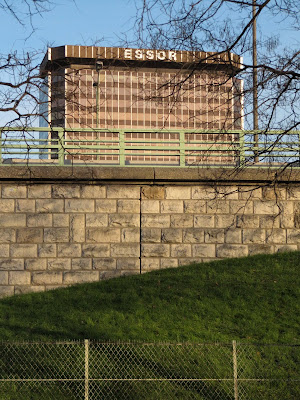
A strange but compelling mixture of detailed description filled with circumstantial fact, philosophical reflection and the freest imaginative riffs, the book seems deliberately to set out to conflate any distinction between conscious fact and the unconscious fantasy. It seems to be the man's contention that what we believe we see as the real world is in fact a sort of convention, and represents a tiny fraction of the things that occur around us. Certain phenomena in the text share many parallels with those we've long been tracking on this blog. It would seem that, in Paris, as in London, for instance, there may be occult forces, let's say, inherent in certain locations which appear on the surface nothing special, but which careful investigation may be able to uncover. If the parallels are real, then, the wonders of pubsignstakenforwonders may not in fact be new in themselves, as it's been our tendency to believe, and may have been around long before Aragon himself wrote of them in the twenties.


The other text I investigated on that first day, though in relation to my experiences, it is more problematic, was perhaps no less illuminating.

Immediately after the visit to the Buttes Chaumont, I went in search of more places annotated in the map the St Pancras man had left with me as having been mine. 
The nearest of these was at the perimeter, around the Boulevard Périphérique - the city's ring road. The book as the man had presented it was, although described as a novel, based on close factual description of a small suburban area and its inhabitants, on the one hand, and the life and times of a true historical figure who had given his name to a street at its centre - Avenue Ney, after the marshal of the Napoleonic era.

Densely descriptive, the text kept returning to a few essential features which had stuck in my memory thanks to the account at St Pancras. The cheap and characterless hotels, mostly there to serve the motorway, in which the narrator lived, the cafés, canal bridges, high-rise blocks, railway lines, and, at the heart of the story, beneath the motorway itself with its almost Ballardian vocabulary of approach roads and sidings, the pillars supporting its flyover, in which, the man insisted, the main characters lived.


It was in search of these details I went from the Buttes, then, in the expectation I might jog my memory. There was no way to be sure that the high rises I saw, the bridges and hotels were the right ones, but certainly the lexicon of forms was clearly recognisable. Whether or not the text, whichever side it lay of the divide between fiction or journalism, really existed, here at least was evidence that its subject matter was real. And even though, as at the Buttes, I couldn't be sure whether it was as a result of having visited before, read about it, or only as a result of the King's Cross man's description, my experience was certainly one of recognition. I don't think I thought at the time it was stuff for the blog. Rather, if I photographed, it was for evidence of the recognition, for later, when I'd be able to put it all together.

Now is perhaps that later. Since Jean Rolin's La Clôture, which answers to every detail of the St Pancras account, was published in 2002, it is quite impossible that I should have read it when I knew the St Pancras man, described it to him, or written the annotations on the map he claimed had been mine.

However, if this might suggest ruling out his entire story, other things still suggest otherwise. My experiences with the Aragon text, for instance, were similar, but that text I certainly could have read. And then, given the parallels in the Aragon text with our experiences here in London, if I was to apply its principles, as I clearly should, it may be that my sense of recognition, outweighing any narrow conception of factual possibility, should dictate its figuring in a blog such as this, bent on uncovering, not the superficial, but the underlying facts.

These, then, were the two mysteries presenting themselves to me at the end of the first day in Paris. Whether or not the events of the second day resolved the puzzle, I cannot yet say. However, the very least that I had was good reason to continue the search, and you can be sure I took as close a record of my activities as usual.


















you are making poetry out of lafarge and essor ! great job !
ReplyDeleteThanks! A name like Lafarge, it must be said, treads strangely close to poetry in itself, and then, tracking the footsteps of Rolin's somehow far from unpoetic prose...
ReplyDelete